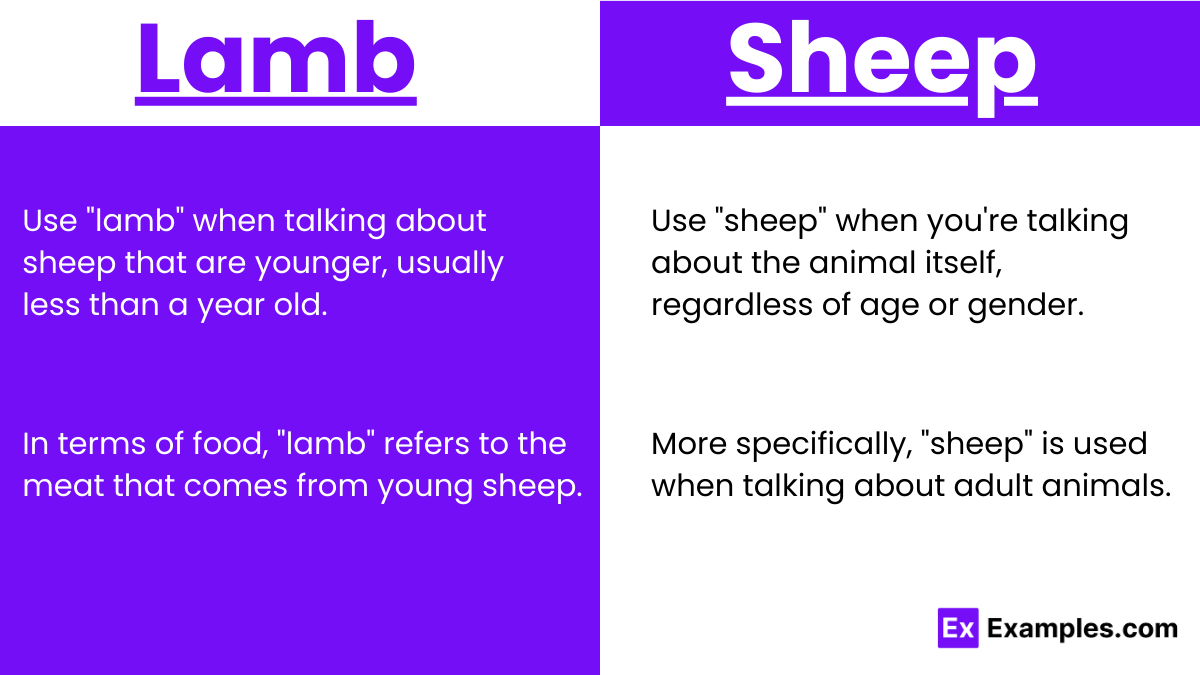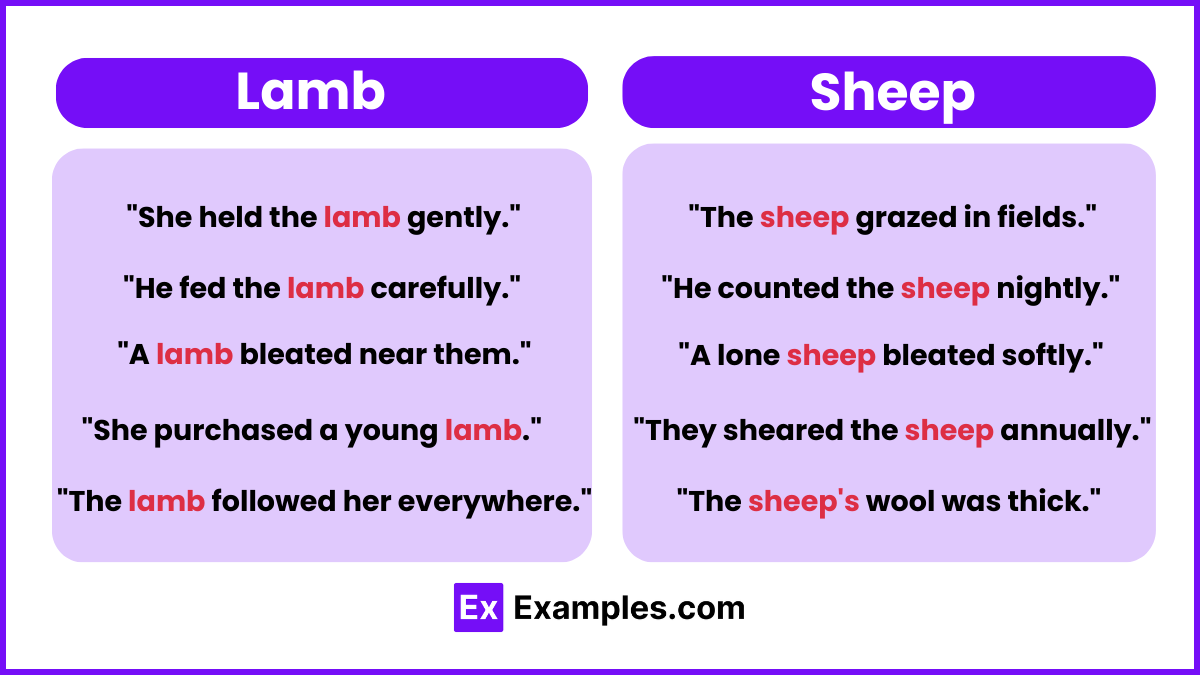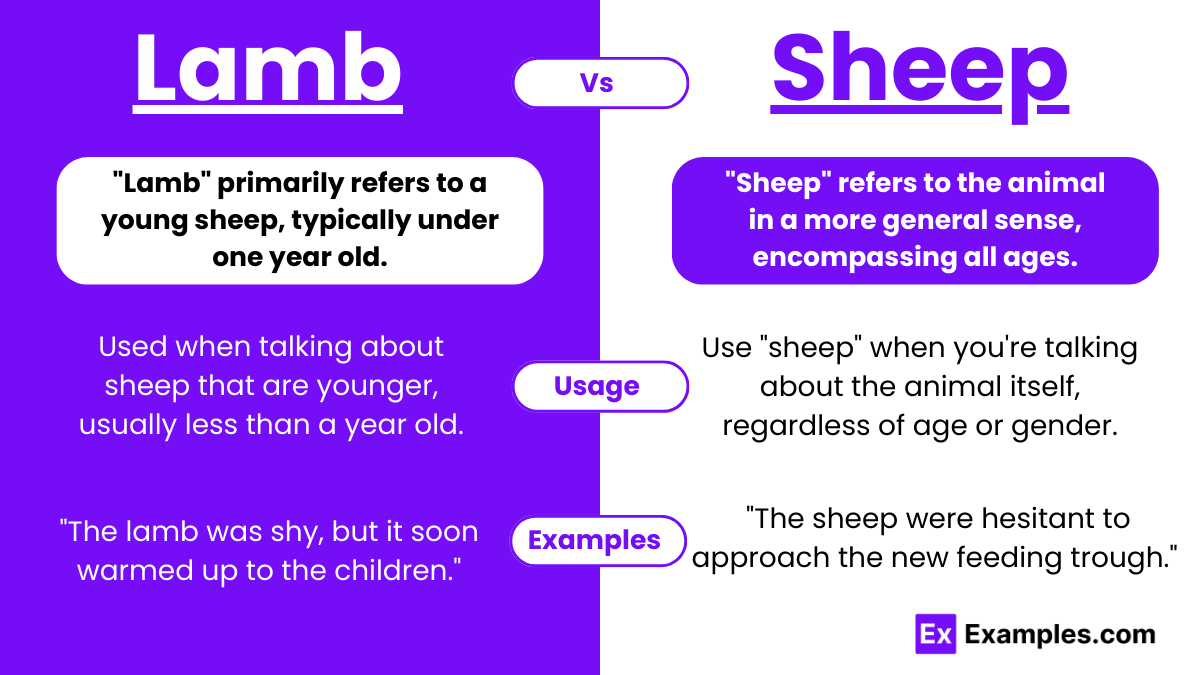Lamb vs Sheep – Difference, Meanings, Examples, Usage
Understanding the distinction between “Lamb” and “Sheep” is crucial for clear communication, especially in contexts related to agriculture, cuisine, and textiles. These terms are often used interchangeably by those outside of farming or culinary industries, leading to confusion. The terms “Lamb” and “Sheep” are integral to animal husbandry, cuisine, and textiles, each referring to different stages in the life of the same animal or their products. This guide is designed to clarify these terms, enabling you to use them accurately in your conversations and writing.
Lamb and Sheep – Meanings
- Lamb: “Lamb” primarily refers to a young sheep, typically under one year old. In the context of meat, “lamb” denotes the meat from these young sheep, which is known for its tender texture and mild flavor. Lambs are often associated with spring, symbolizing renewal and festivity in various cultures. In textiles, “lamb wool” comes from the first shearing of a sheep, considered extremely soft and fine.
- Sheep: “Sheep,” on the other hand, refers to the animal in a more general sense, encompassing all ages. Adult sheep are known for their wool, which is a key raw material in the textile industry. In terms of meat, the term “mutton” is used to describe the meat from mature sheep, which has a stronger flavor and tougher texture compared to lamb.
Summary
“Lamb” denotes young sheep and their meat, valued for its tenderness and mild flavor, and is also used to describe soft, fine wool from a lamb’s first shearing. “Sheep” is a more encompassing term that refers to the animal at any age, with adult sheep providing wool for textiles and mutton for cuisine. The distinction is essential in agriculture, culinary arts, and textiles, where the age and product type greatly matter.
How to pronounce Lamb and Sheep
Lamb: Pronounced as /læm/ (lam).
Sheep: Pronounced as /ʃiːp/ (sheep).
Differences between Lamb and Sheep
| Aspect | Lamb | Sheep |
|---|---|---|
| Definition | Refers to young sheep, typically under one year old. | Refers to the species as a whole, at any age. |
| Cuisine | Meat known as “lamb,” prized for its tenderness. | Meat from adults known as “mutton,” stronger in flavor. |
| Textiles | “Lamb wool” from the first shearing, very soft. | Wool from adult sheep varies by age and breed. |
| Symbolism | Symbolizes innocence, renewal, especially in spring. | Represents broader concepts like sacrifice, pastoral life. |
How to Remember the Difference between Lamb and Sheep
To distinguish between “lamb” and “sheep,” remember that “lamb” refers to young sheep and their tender meat, while “sheep” is a broader term that includes animals of all ages and is associated with wool production and mutton.
When to Use Lamb and Sheep

Usage of Lamb
- Referring to a Young Sheep: Use “lamb” when talking about sheep that are younger, usually less than a year old. It’s like calling a young dog a puppy.
- Talking About Meat: In terms of food, “lamb” refers to the meat that comes from young sheep. So, when you see “lamb” on a menu, it’s referring to the type of meat, not an adult sheep.
Usage of Sheep
- Talking About the Animal in General: Use “sheep” when you’re talking about the animal itself, regardless of age or gender. It’s the general term for the species.
- Referring to Adults: More specifically, “sheep” is used when talking about adult animals. Once a lamb grows up, it’s called a sheep.
- Counting or Mentioning in Groups: When you’re referring to more than one, you would say “sheep” for both singular and plural. Whether it’s one sheep or many, the word doesn’t change.
Lamb and Sheep – Examples

Lamb Examples
- Initially, the lamb was shy, but it soon warmed up to the children.
- Furthermore, the shepherd mentioned that the lamb had been born just that spring.
- Consequently, the lamb’s wool was exceptionally soft and fluffy.
- For instance, feeding a lamb requires special milk formula.
- Moreover, the lamb’s playful antics brought joy to everyone on the farm.
- Similarly, another lamb joined in, and they frolicked together in the meadow.
Sheep Examples
- Initially, the sheep were hesitant to approach the new feeding trough.
- Furthermore, the farmer decided to shear the sheep to prepare them for summer.
- Consequently, the sheep looked quite different without their thick coats.
- For instance, one sheep always seemed to lead the others back to the barn at dusk.
- Moreover, the sheep’s wool was used to make warm sweaters and blankets.
- Similarly, the neighboring farm also raised sheep for their high-quality wool.
Synonyms
| Term | Synonyms |
|---|---|
| Lamb | Juvenile, Youngling, Fledgling |
| Sheep | Ovine, Ewe/Ram, Flock Member, Wool-bearer |
Exercise
- The festival menu featured roasted _______ with herbs.
- _______ herding is a traditional occupation in many rural areas.
- The _______ market prices fluctuate with seasons.
- Wool from _______ is highly valued in the textile industry.
- Herding _______ requires skill and patience.
- Hand-knitted sweaters made from _______ wool are very warm.
Answers
- lamb
- Sheep
- lamb
- sheep
- Sheep
- lamb
FAQ’S
Are Lamb and Sheep the Same?
Lamb refers to young sheep, typically under a year old, while “sheep” encompasses animals of all ages.
Why Do They Call It Lamb Instead of Sheep?
“Lamb” specifically denotes the meat from young sheep, highlighting its tenderness compared to mature sheep meat.
Is a Sheep a Baby Lamb?
No, a sheep can be any age. “Lamb” exclusively refers to young sheep, usually less than a year old.
Is Lamb a Female Sheep?
Lamb can be either male or female; it signifies the animal’s youth, not its gender.
Why Is Jesus Called the Lamb of God?
Jesus is called the “Lamb of God” symbolizing sacrifice and redemption, akin to sacrificial lambs in religious rites.
What Do You Call a Female Lamb?
A female lamb is simply called a “lamb” until maturity, after which it is known as an “ewe.


